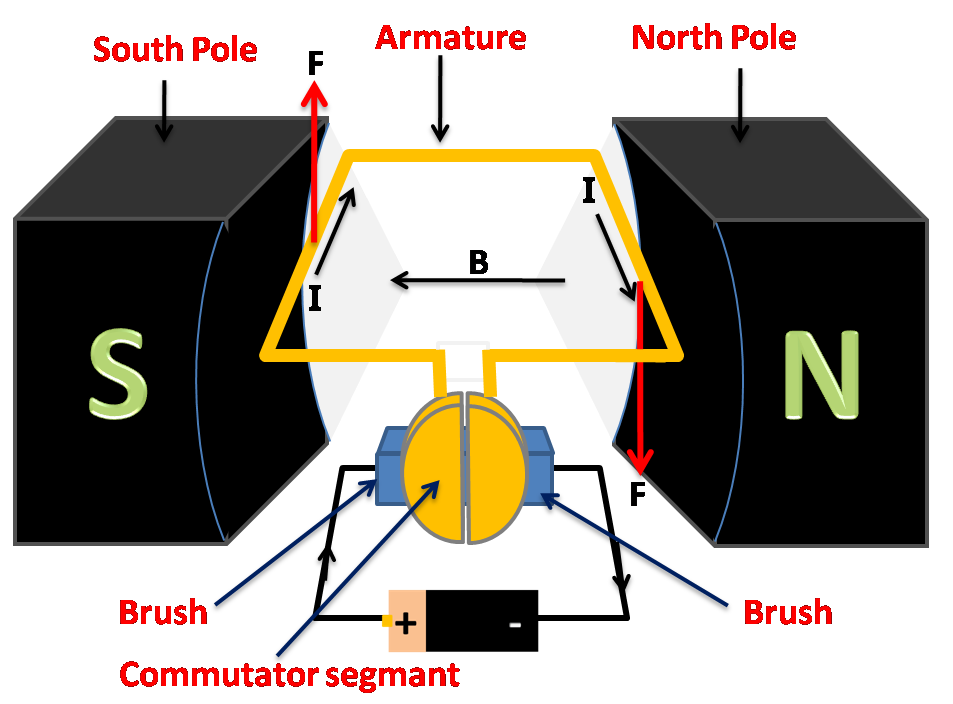
Explain the working of an electric motor with a neat diagram.
Answer
583.5k+ views
Hint: Electric motors are common in our daily life. It works with Fleming's left-hand rule. The combined effect of the magnetic field and electric current will cause a force that helps to the rotation of the coil. This mechanical work can be used for various applications.
Complete step-by-step answer:

An electric motor can convert the electric energy to the mechanical energy and it operates with the interaction between the magnetic field and winding current. We can see this, almost in every motor that we are using for several purposes. According to the principle of electric motors, when a current-carrying rectangular coil is placed in a magnetic field, it will rotate due to the force acting on that.
An electric motor mainly consists of a core, coil, commutator, brushes, magnet and battery. The coil is used to developing the magnetic field when a current flows through it. The commutator is used to change the direction of current when half of the rotation is completed. Brushes used to provide the electric current to the circulating coil continuously. Magnet is used to set up the magnetic field in the system.
A DC motor depends upon Fleming’s left-hand rule. Here, a DC flowing armature coil is placed between the magnetic poles. According to Fleming’s left-hand rule, a current-carrying coil in a magnetic field will experience a force perpendicular to the direction magnetic field and current flow. This force will help to rotate the armature. The current will reverse after every half of the rotation. So that the rotation of armature will continue in a single direction.
Additional information:
Fleming’s left-hand rule states that, if a current-carrying coil is placed in the magnetic field, it will experience a force. We can illustrate the direction of this force by using the fingers of the left hand. The forefinger represents the direction of the current, the middle finger represents the direction of the magnetic field and the thumb represents the force direction.
Note: Split rings have great importance to alter the direction of the coil. If it is not used, the armature coil will rotate clockwise and anticlockwise repeatedly. So we are using split rings to reverse the current flow thereby we can rotate the armature coil continuously in a single direction. We will use a soft iron core inside the coils and this is known as an armature. It will increase the power of the electric motor. If we are using solid and rigid materials instead of brushes, it will disturb the rotational motion. That’s why we are preferring brush-like structure for the current flow.
Complete step-by-step answer:

An electric motor can convert the electric energy to the mechanical energy and it operates with the interaction between the magnetic field and winding current. We can see this, almost in every motor that we are using for several purposes. According to the principle of electric motors, when a current-carrying rectangular coil is placed in a magnetic field, it will rotate due to the force acting on that.
An electric motor mainly consists of a core, coil, commutator, brushes, magnet and battery. The coil is used to developing the magnetic field when a current flows through it. The commutator is used to change the direction of current when half of the rotation is completed. Brushes used to provide the electric current to the circulating coil continuously. Magnet is used to set up the magnetic field in the system.
A DC motor depends upon Fleming’s left-hand rule. Here, a DC flowing armature coil is placed between the magnetic poles. According to Fleming’s left-hand rule, a current-carrying coil in a magnetic field will experience a force perpendicular to the direction magnetic field and current flow. This force will help to rotate the armature. The current will reverse after every half of the rotation. So that the rotation of armature will continue in a single direction.
Additional information:
Fleming’s left-hand rule states that, if a current-carrying coil is placed in the magnetic field, it will experience a force. We can illustrate the direction of this force by using the fingers of the left hand. The forefinger represents the direction of the current, the middle finger represents the direction of the magnetic field and the thumb represents the force direction.
Note: Split rings have great importance to alter the direction of the coil. If it is not used, the armature coil will rotate clockwise and anticlockwise repeatedly. So we are using split rings to reverse the current flow thereby we can rotate the armature coil continuously in a single direction. We will use a soft iron core inside the coils and this is known as an armature. It will increase the power of the electric motor. If we are using solid and rigid materials instead of brushes, it will disturb the rotational motion. That’s why we are preferring brush-like structure for the current flow.
Recently Updated Pages
Master Class 12 English: Engaging Questions & Answers for Success

Master Class 12 Social Science: Engaging Questions & Answers for Success

Master Class 12 Chemistry: Engaging Questions & Answers for Success

Which is the Longest Railway Platform in the world?

India Manned Space Mission Launch Target Month and Year 2025 Update

Which of the following pairs is correct?

Trending doubts
What are the major means of transport Explain each class 12 social science CBSE

Which are the Top 10 Largest Countries of the World?

Draw a labelled sketch of the human eye class 12 physics CBSE

How much time does it take to bleed after eating p class 12 biology CBSE

Explain sex determination in humans with line diag class 12 biology CBSE

Plot a graph between potential difference V and current class 12 physics CBSE




